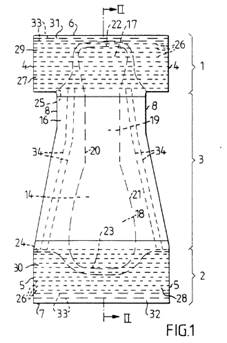|
合衆国最高裁判決
SCA Hygiene
Products v. First Quality Baby Products
2017年3月23日
286条で規定する法定期限内の損害賠償に対してラッチス(懈怠)
のディフェンス(防御)を適用できるか?
SCOTUS
No. 15-927
Summarized by Tatsuo YABE –
2017-03-30
|
|
暫くの間、あまり耳にしなかった衡平法による救済の一つとしてラッチス(懈怠:権利者が理不尽なほどに訴訟の開始時期を遅らせ、結果的に被疑侵害者に被疑侵害行為の継続を容認したかのような印象を与える)に対する最高裁判決がでた。著作権に関して最高裁は、2014年5月19日、法定期限3年間の損害賠償額に対しラッチスによる救済は認められないとしたPetrella
v. Metro-Goldwyn-Mayer。尚、特許に関して、2015年9月18日、CAFC大法廷では6:5で自身のパネル判決を支持し、286条で規定する6年間であってもラッチスによる救済を認める(ラッチスが適用されれば訴訟提起前6年の間に生じた損害賠償を免罪する)という判決を出した。今回、2017年3月23日、最高裁は7:1でCAFC大法廷判決を破棄し、286条で規定する損害賠償の遡及期間である6年間(訴訟提起前の6年間)に生じた損害賠償に対してラッチスのディフェンスは適用されないと判示した。依って、特許権者による訴訟の開始時期の判断により広い自由度を齎し、技術分野によっては訴訟開始時期を遅らせることによって(被疑侵害者が巨額の設備投資をし事業からの撤退が困難になる時期を見計らって訴訟を提起するなど)被疑侵害者に対して優位な立場になれることにお墨付きを与えたことになる。このように、今回の最高裁判決は、特許権者にとって一方的に有利な判決のようではあるが、特許権者が被疑侵害者を警告し、その後のやりとりで、恰も被疑侵害者の行為を容認するような印象を与えたという事実があれば衡平法の禁反言による救済(損害賠償額の減額)が少なくとも発動されるであろう。(以上筆者)
|
□□□□□□□□□□□□□□□□□□□□□□□□□□□□□
以下最高裁判決に至った経緯と背景事実:(判決理由省く)
|
2017年3月23日、合衆国最高裁は以下の争点に対して7:1で判示した。
争点:286条で規定する法定期限(6年)内の損害賠償に対して被疑侵害者はラッチス(懈怠)に依拠し法的救済(損害賠償を回避)を求められるか?
□ 最高裁の多数判決(7人を代表しAlito裁判官による)
286条の法定期限内(6年以内)に生じた損害賠償に対してラッチスのディフェンスは適用されない。
□ 最高裁反対意見:(Breyer裁判官)
多数意見のように、ラッチスを認めないとすると、現実的な側面として、特許権者は被疑侵害者のビジネスの動向を観察し、多く設備投資をし、当該ビジネスからの撤退或いは切り替えが困難になる時期まで訴訟の提起を遅らせることに対する動機付けとなる。唯一、多数意見による衡平法による禁反言による救済に期待する。
|
□ 事実関係:
特許権者:SCA
Hygiene Products Aktiebolag et al.
被疑侵害者:First
Quality Baby Products
問題となった特許:
USP 6,375,646 (“646特許”)
|
SCAの特許: 成人用オムツ
|
代表図
|
|
A disposable, absorbent pants-type diaper includes a front-part (1), a
back-part (2), a crotch-part (3) between the front and back parts (1, 2),
at least two side-closure parts (12, 13) which mutually join parts of the
side-edges (4, 5) of respective front and back parts, so that the pants
will present a waist opening (9) and two leg openings (10, 11). The diaper
pants further include an elongated absorbent pad (14), an inner casing
layer (15), and an outer casing layer (16). At least one of the respective
front and back parts (1, 2) has at least one elastically stretchable
region (29, 30). The crotch-part (3) is essentially non-stretchable in
relation to the stretchable region (29, 30). At least one of respective
end-parts (17, 18) of the absorbent pad (14) is disposed within one of the
elastically stretchable regions (29, 30), while the center-part (19) of
the absorbent pad is disposed within the relatively non-stretchable
crotch-part (3) of the pants.
|

|
|
背景:
2003年10月31日、SCAはFirst
Quality社に対してSCAの646特許を侵害を警告した。2003年11月21日、First社は自身の特許(US5415649:以下”US649”)によってSCAの646特許は新規性がないと反論した。
2004年7月にSCAはFirstのUSP649を基に646特許の再審査を請求した。
2007年3月、USPTOは再審査の結果、SCAの646特許(全てのクレーム)の有効性を認めた。
2010年8月2日、SCAはFirst社を相手に侵害訴訟を提起した。First社はラッチス(懈怠)と禁反言を理由に衡平法による救済を求めた。
********************************
注意:2003年11月にFirst社がSCAに応答してから2010年までの約7年もの期間、当事者間における連絡はなかった。2006年以降、First社はTyco
Healthcare社を買収するなど成人用オムツの製造規模を拡大し、2009年にはUS$10Millionの投資をし、さらに製造ラインを拡大した。この間、(約7年間)SCAはFirst社のビジネス状況を周知しているも、静観していた。
*********************************
2013年7月、地裁はFirst社の請求(懈怠)を認め略式判決を出した。
2014年5月19日、(SCAの控訴中)最高裁は著作権に関する損害賠償請求の法定期限3年に対するPetrella
v. Metro-Goldwyn-Mayer判決を判示した。
2014年9月17日、CAFCは最高裁のPetrella判決を考慮するも地裁判決を支持した(即ち、ラッチスによる衡平法による救済を認めた)。
2015年9月18日、CAFC大法廷は6:5(僅差)で自身のパネル判決(2014-09-07)を支持した。
|
□□□□□□□□□□□□□□□□□□□□□□□□□□□□□□
|
以下参考:REFERENCE
|
35 U.S.C. 282
Presumption of validity; defenses.
·
(a) IN GENERAL.—A
patent shall be presumed valid. Each claim of a patent (whether in independent,
dependent, or multiple dependent form) shall be presumed valid independently of
the validity of other claims; dependent or multiple dependent claims shall be
presumed valid even though dependent upon an invalid claim. The burden of
establishing invalidity of a patent or any claim thereof shall rest on the party
asserting such invalidity.
·
(b) DEFENSES.—The following shall be defenses in any action
involving the validity or infringement of a patent and shall be pleaded:
·
(1) Noninfringement,
absence of liability for infringement, or unenforceability.
·
(2) Invalidity of the
patent or any claim in suit on any ground specified in part II
as
a condition for patentability.
·
(3) Invalidity of the
patent or any claim in suit for failure to comply with—
·
(A) any requirement of section
112 ,
except that the failure to disclose the best mode shall not be a basis on which
any claim of a patent may be canceled or held invalid or otherwise
unenforceable; or
·
(B) any requirement of
section 251
.
·
(4) Any other fact or act
made a defense by this title.
·
(c) NOTICE OF ACTIONS;
ACTIONS DURING EXTENSION OF PATENT TERM.— In an action involving the
validity or infringement of a patent the party asserting invalidity or
noninfringement shall give notice in the pleadings or otherwise in writing to
the adverse party at least thirty days before the trial, of the country, number,
date, and name of the patentee of any patent, the title, date, and page numbers
of any publication to be relied upon as anticipation of the patent in suit or,
except in actions in the United States Court of Federal Claims, as showing the
state of the art, and the name and address of any person who may be relied upon
as the prior inventor or as having prior knowledge of or as having previously
used or offered for sale the invention of the patent in suit. In the absence of
such notice proof of the said matters may not be made at the trial except on
such terms as the court requires.
Invalidity
of the extension of a patent term or any portion thereof under section
154(b)
or
156
because
of the material failure—
·
(1) by the applicant for
the extension, or
·
(2) by the Director,
to
comply with the requirements of such section shall be a defense in any action
involving the infringement of a patent during the period of the extension of its
term and shall be pleaded. A due diligence determination under section
156(d)(2)
is
not subject to review in such an action.
|
(Amended July 24, 1965, Public Law 89-83, sec. 10, 79
Stat. 261; Nov. 14, 1975, Public Law 94-131, sec. 10, 89 Stat. 692; Apr. 2,
1982, Public Law 97-164, sec. 161(7), 96 Stat. 49; Sept. 24, 1984, Public Law
98-417, sec. 203, 98 Stat. 1603; Oct. 29, 1992, Public Law 102-572, sec.
902(b)(1), 106 Stat. 4516; Nov. 1, 1995, Public Law 104-41, sec. 2, 109 Stat.
352; Nov. 29, 1999, Public Law 106-113, sec. 1000(a)(9), 113 Stat. 1501A-560,
582 (S. 1948 secs. 4402(b)(1) and 4732(a)(10)(A)); amended Sept. 16, 2011,
Public Law 112-29, sec. 15(a) (effective Sept. 16, 2011) and secs. 20(g) and (j)
(effective Sept. 16, 2012), 125 Stat. 284.)
|
35 U.S.C. 286 Time limitation
on damages.
Except as otherwise provided by law, no
recovery shall be had for any infringement committed more than six
years prior to the filing of the complaint or counterclaim for infringement in the
action.
In the case of claims against the United
States Government for use of a patented invention, the period before bringing
suit, up to six years, between the date of receipt of a written claim for
compensation by the department or agency of the Government having authority to
settle such claim, and the date of mailing by the Government of a notice to the
claimant that his claim has been denied shall not be counted as a part of the
period referred to in the preceding paragraph.
|
